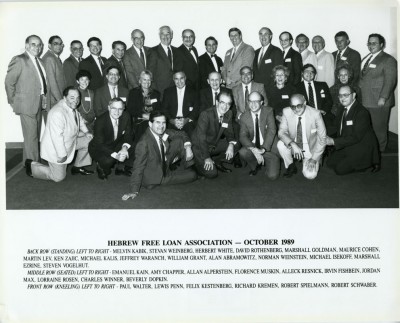MS 206 The Felix Kestenberg Collection
The Felix Kestenberg (1921-2008)
Collection
n.d., 1987-2008
MS 206
Jewish Museum of Maryland
ACCESS AND PROVENANCE
The Felix Kestenberg collection was donated to the Jewish Museum of Maryland by Veronica Kestenberg in 2010 as accession 2010.69. The collection was processed by Jennifer Vess in 2012.
Access to the collection is unrestricted and available to researchers at the Jewish Museum of Maryland. Researchers must obtain written permission of the Jewish Museum of Maryland before publishing quotations from materials in the collection. Papers may be copied in accordance with the library’s usual practices

Hebrew Free Loan Association - October 1989. Felix Kestenberg kneels third from the left in the front row. 2010.69.6
BIOGRAPHICAL NOTE
Felix Kestenberg was born in 1921 in Radom, Poland, the son of a shoe manufacturer. In 1939 he was sent to a labor camp on the border of Russia and was moved to seven other camps including Auschwitz and Maidanek. In January 1945, he was marched to Dachau. The camp was liberated on April 29, 1945 by American troops. He was the only member of his family to survive.
Kestenberg moved to Baltimore in 1949 to live with his uncle Leo Altfeder. Kestenberg’s first jobs included TV repairman and roofer. He eventually joined his uncle’s clothing business and later worked for London Fog and Misty Harbor Outerwear.
Kestenberg was active in the Jewish community serving in various positions for the Hebrew Free Loan Society, the Hebrew Immigration Aid Society and Jewish Family Services. Under the Jewish Family Services he served as the chair for the Holocaust Claims Conference Committee. Kestenberg traveled around Maryland telling his story at schools, churches and synagogues. He was a founding member and long-time supporter of Beth Israel Congregation.
His first wife, Doris Potler, died 1968 and he later married Veronica Salazar. He had three children, David Homoki, Leah Miller and Edith Creeger. Kestenberg died in Baltimore on July 22, 2008.
SCOPE AND CONTENT
The Felix Kestenberg Collection contains photographs, certificates, programs, articles, letters, and DVDs predominantly related to Kestenberg’s work with Holocaust remembrance. The materials reference Kesternberg’s talks given to students, participation in yearly Holocaust remembrance events aroundMaryland, and awards for his accomplishments. The papers are organized with all articles first followed by certificates then materials such as programs and letters related to his talks on the Holocaust. Each grouping of materials is organized chronologically. The DVDs and photographs are stored separately.
